*NURSING > QUESTIONS & ANSWERS > NR 507 Mid-term weeks 1-4; Quiz Score: 110 out of 120. (All)
NR 507 Mid-term weeks 1-4; Quiz Score: 110 out of 120.
Document Content and Description Below
NR 507 Mid-term weeks 1-4 Question 1 What is the most abundant class of plasma protein? Globulin Albumin Clotting factors Complement proteins Question 2 ... Carcinoma in situ is characterized by which changes? Cells have broken through the local basement membrane. Cells have invaded immediate surrounding tissue. Cells remain localized in the glandular or squamous cells. Cellular and tissue alterations indicate dysplasia. Question 3 Which laboratory test is considered adequate for an accurate and reliable diagnosis of gonococcal urethritis in a symptomatic man? Ligase chain reaction (LCR) Gram-stain technique Polymerase chain reaction (PCR) DNA testing Question 4 The Papanicolaou (Pap) test is used to screen for which cancer? Ovarian Uterine Cervical Vaginal Question 5 Causes of hyperkalemia include: Hyperparathyroidism and malnutrition Vomiting and diarrhea Renal failure and Addison disease Hyperaldosteronism and Cushing disease Question 6 What is the major concern regarding the treatment of gonococci infections? Development of antibiotic resistance Changes in virulence Changes in pathogenicity Mutations into different strains Question 7 Hypersensitivity is best defined as a(an): Disturbance in the immunologic tolerance of self-antigens Immunologic reaction of one person to the tissue of another person Altered immunologic response to an antigen that results in disease Undetectable immune response in the presence of antigens Question 8 Which immunoglobulin (Ig) is present in childhood asthma? IgM IgG IgE IgA Question 9 Which criterion is used to confirm a diagnosis of asthma in an 8-year-old child? Parental history of asthma Serum testing that confirms increased immunoglobulin E (IgE) and eosinophil levels Reduced expiratory flow rates confirmed by spirometry testing Improvement on a trial of asthma medication Question 10 Continuous increases in left ventricular filing pressures result in which disorder? Mitral regurgitation Mitral stenosis Pulmonary edema Jugular vein distention Question 11 Which statement best describes a Schilling test? Administration of radioactive cobalamin and the measurement of its excretion in the urine to test for vitamin B12 deficiency Measurement of antigen-antibody immune complexes in the blood to test for hemolytic anemia Measurement of serum ferritin and total iron-binding capacity in the blood to test for iron deficiency anemia Administration of folate and measurement in 2 hours of its level in a blood sample to test for folic acid deficiency anemia. Question 12 How high does the plasma glucose have to be before the threshold for glucose is achieved? 126 mg/dl 150 mg/dl 180 mg/dl 200 mg/dl Question 13 What is the ratio of coronary capillaries to cardiac muscle cells? 1:1 (one capillary per one muscle cell) 1:2 (one capillary per two muscle cells) 1:4 (one capillary per four muscle cells) 1:10 (one capillary per ten muscle cells) Question 14 Deficiencies in which element can produce depression of both B- and T-cell function? Iron Zinc Iodine Magnesium Question 15 Which congenital heart defects occur in trisomy 13, trisomy 18, and Down syndrome? Coarctation of the aorta (COA) and pulmonary stenosis (PS) Tetralogy of Fallot and persistent truncus arteriosus Atrial septal defect (ASD) and dextrocardia Ventricular septal defect (VSD) and patent ductus arteriosus (PDA) Question 16 Which of the following is classified as a megaloblastic anemia? Iron deficiency Pernicious Sideroblastic Hemolytic Question 17 The lung is innervated by the parasympathetic nervous system via which nerve? Vagus Phrenic Brachial Pectoral Question 18 Which organ is stimulated during the alarm phase of the general adaptation syndrome (GAS)? Adrenal cortex Hypothalamus Anterior pituitary Limbic system Question 19 Which type of antibody is involved in type I hypersensitivity reaction? IgA IgE IgG IgM Question 20 What is the life span of an erythrocyte (in days)? 20 to 30 60 to 90 100 to 120 200 to 240 Question 21 What is the life span of platelets (in days)? 10 30 90 120 Question 22 Perceived stress elicits an emotional, anticipatory response that begins where? Prefrontal cortex Anterior pituitary Limbic system Hypothalamus Question 23 What is the final stage of the infectious process? Colonization Invasion Multiplication Spread Question 24 The coronary ostia are located in the: Left ventricle Aortic valve Coronary sinus Aorta Question 25 Which hepatitis virus is known to be sexually transmitted? A B C D Question 26 What process allows the kidney to respond to an increase in workload? Glomerular filtration Secretion of 1,25-dihydroxyvitamin D3 Increased heart rate Compensatory hypertrophy Question 27 Which cardiac chamber has the thinnest wall and why? The right and left atria; they are low-pressure chambers that serve as storage units and conduits for blood. The right and left atria; they are not directly involved in the preload, contractility, or afterload of the heart. The left ventricle; the mean pressure of blood coming into this ventricle is from the lung, which has a low pressure. The right ventricle; it pumps blood into the pulmonary capillaries, which have a lower pressure compared with the systemic circulation. . Question 28 Which hormone is synthesized and secreted by the kidneys? Antidiuretic hormone Aldosterone Erythropoietin Angiotensinogen Question 29 If the sinoatrial (SA) node fails, then at what rate (depolarizations per minute) can the atrioventricular (AV) node depolarize? 60 to 70 40 to 60 30 to 40 10 to 20 If the SA node is damaged, then the AV node will become the heart’s pacemaker at a rate of approximately 40 to 60 spontaneous depolarizations per minute. Question 30 What is the purpose of the spirometry measurement? To evaluate the cause of hypoxia To measure the volume and flow rate during forced expiration To measures the gas diffusion rate at the alveolocapillary membrane To determine pH and oxygen and carbon dioxide concentrations Question 31 Fetal hematopoiesis occurs in which structure? Gut Spleen Bone marrow Thymus Question 32 What effects do exercise and body position have on renal blood flow? Exercise and body position activate renal parasympathetic neurons and cause mild vasoconstriction. They activate renal sympathetic neurons and cause mild vasoconstriction. Both activate renal parasympathetic neurons and cause mild vasodilation. They activate renal sympathetic neurons and cause mild vasodilation. Question 33 Which primary characteristic is unique for the immune response? The immune response is similar each time it is activated. The immune response is specific to the antigen that initiates it. The response to a specific pathogen is short term. The response is innate, rather than acquired. Question 34 What is the most common cause of insufficient erythropoiesis in children? Folic acid deficiency Iron deficiency Hemoglobin abnormality Erythrocyte abnormality Question 35 What are the abnormalities in cytokines found in children with cystic fibrosis (CF)? Deficit of interleukin (IL)–1 and an excess of IL-4, IL-12, and interferon-alpha (IFN-α) Deficit of IL-6 and an excess of IL-2, IL-8, and granulocyte colony-stimulating factor (G-CSF) Deficit of IL-10 and an excess of IL-1, IL-8, and TNF-α Deficit of IL-3 and an excess of IL-14, IL-24, and colony-stimulating factor (CSF) Question 36 Decreased lung compliance means that the lungs are demonstrating which characteristic? Difficult deflation Easy inflation Stiffness Inability to diffuse oxygen Question 37 What is the action of urodilatin? Urodilatin causes vasoconstriction of afferent arterioles. It causes vasodilation of the efferent arterioles. Urodilatin inhibits antidiuretic hormone secretion. It inhibits salt and water reabsorption. Question 38 The function of the foramen ovale in a fetus allows what to occur? Right-to-left blood shunting Left-to-right blood shunting Blood flow from the umbilical cord Blood flow to the lungs Question 39 Examination of the throat in a child demonstrating signs and symptoms of acute epiglottitis may contribute to which life-threatening complication? Retropharyngeal abscess Laryngospasms Rupturing of the tonsils Gagging induced aspiration Question 40 Which statement concerning benign tumors is true? The resulting pain is severe. Benign tumors are not encapsulated. Benign tumors are fast growing. The cells are well-differentiated. Question 41 What is the role of collagen in the clotting process? Initiates the clotting cascade. Activates platelets. Stimulates fibrin. Deactivates fibrinogen. Question 42 What effect do natriuretic peptides have during heart failure when the heart dilates? Stimulates antidiuretic hormones. Inhibits antidiuretic hormones. Stimulates renin and aldosterone. Inhibits renin and aldosterone. Question 43 Which cells have phagocytic properties similar to monocytes and contract like smooth muscles cells, thereby influencing the glomerular filtration rate? Principle cells Podocin cells Mesangial cells Intercalated cells Question 44 During an IgE-mediated hypersensitivity reaction, which leukocyte is activated? Neutrophils Monocytes Eosinophils T lymphocytes Question 45 The most common site of metastasis for a patient diagnosed with prostate cancer is which location? Bones Brain Bladder Kidney Question 46 Research supports the premise that exercise has a probable impact on reducing the risk of which cancer? Liver Endometrial Stomach Colon Question 47 When a patient has small, vesicular lesions that last between 10 and 20 days, which sexually transmitted infection is suspected? Genital herpes Chancroid Syphilis Chlamydia Question 48 The glomerular filtration rate is directly related to which factor? Perfusion pressure in the glomerular capillaries Diffusion rate in the renal cortex Diffusion rate in the renal medulla Glomerular active transport Question 49 Which disorder results in decreased erythrocytes and platelets with changes in leukocytes and has clinical manifestations of pallor, fatigue, petechiae, purpura, bleeding, and fever? Idiopathic thrombocytopenic purpura (ITP) Acute lymphocytic leukemia (ALL) Non-Hodgkin lymphoma (NHL) Iron deficiency anemia (IDA) Question 50 Which complex (wave) represents the sum of all ventricular muscle cell depolarizations? PRS QRS QT interval P Question 51 Which cytokines initiate the production of corticotropin-releasing hormone (CRH)? IL–1 and IL-6 IL-2 and TNF-α IFN and IL-12 TNF-ß and IL-4 Question 52 Innervation of the bladder and internal urethral sphincter is supplied by which nerves? Peripheral nerves Parasympathetic fibers Sympathetic nervous system Tenth thoracic nerve roots Question 53 Which T-lymphocyte phenotype is the key determinant of childhood asthma? Cluster of differentiation (CD) 4 T-helper Th1 lymphocytes CD4 T-helper Th2 lymphocytes CD8 cytotoxic T lymphocytes Memory T lymphocytes Question 54 What is the primary site for uncomplicated local gonococci infections in men? Epididymis Lymph nodes Urethra Prostate Question 55 What is the trigone? A smooth muscle that comprises the orifice of the ureter The inner mucosal lining of the kidneys A smooth triangular area between the openings of the two ureters and the urethra One of the three divisions of the loop of Henle Question 56 What part of the kidney controls renal blood flow, glomerular filtration, and renin secretion? Macula densa Visceral epithelium Juxtaglomerular apparatus (JGA) Filtration slits Question 57 What is the primary problem resulting from respiratory distress syndrome (RDS) of the newborn? Consolidation Pulmonary edema Atelectasis Bronchiolar plugging Question 58 Infants are most susceptible to significant losses in total body water because of an infant’s: High body surface–to–body size ratio Slow metabolic rate Kidneys are not mature enough to counter fluid losses Inability to communicate adequately when he or she is thirsty Question 59 What is the first stage in the infectious process? Invasion Colonization Spread Multiplication Question 60 It has been determined that a tumor is in stage 2. What is the meaning of this finding? Cancer is confined to the organ of origin. Cancer has spread to regional structures. Cancer is locally invasive. Cancer has spread to distant sites Quiz Score: 110 out of 120 PreviousNext [Show More]
Last updated: 1 year ago
Preview 1 out of 33 pages
.png)
Buy this document to get the full access instantly
Instant Download Access after purchase
Add to cartInstant download
We Accept:

Reviews( 0 )
$16.00
Document information
Connected school, study & course
About the document
Uploaded On
Oct 16, 2020
Number of pages
33
Written in
Additional information
This document has been written for:
Uploaded
Oct 16, 2020
Downloads
0
Views
44

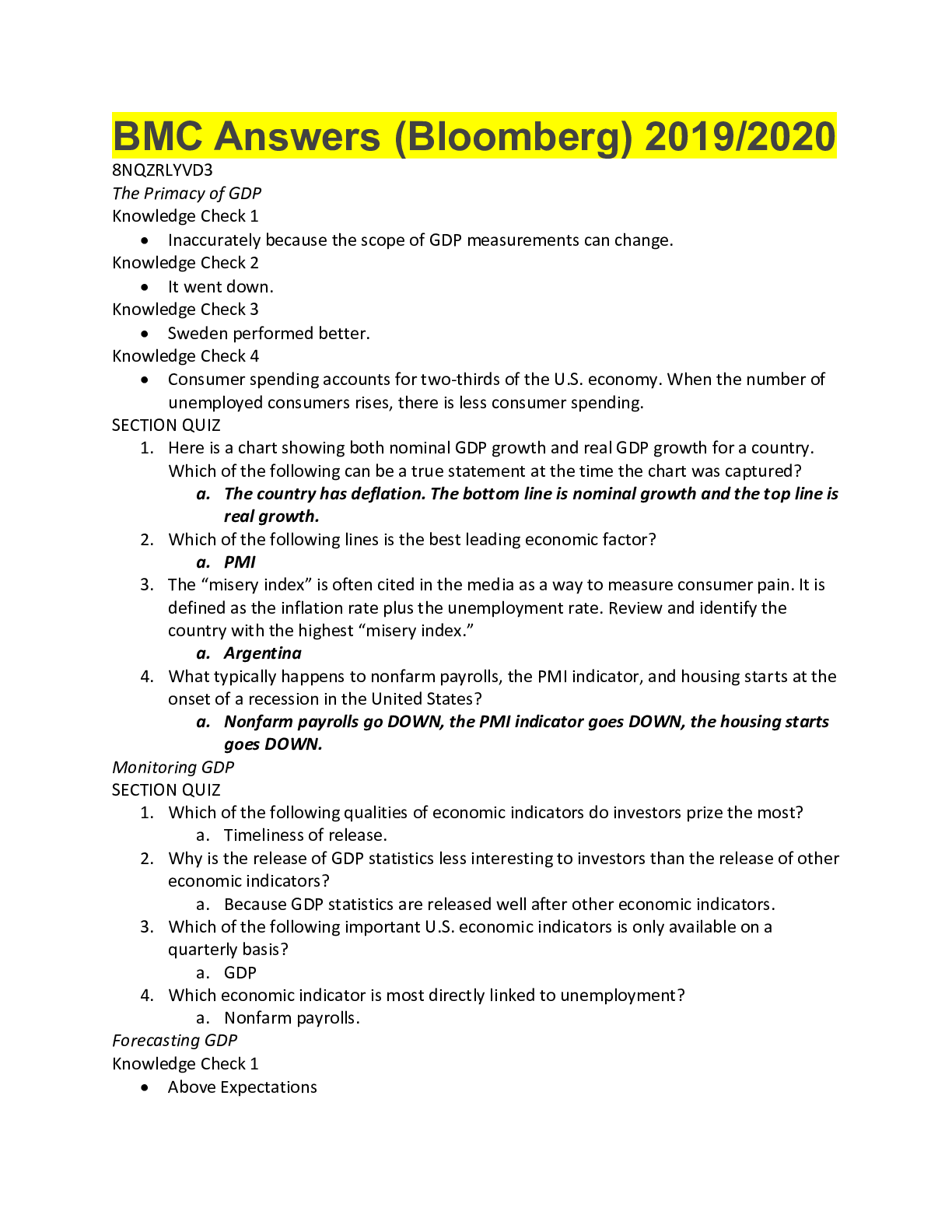
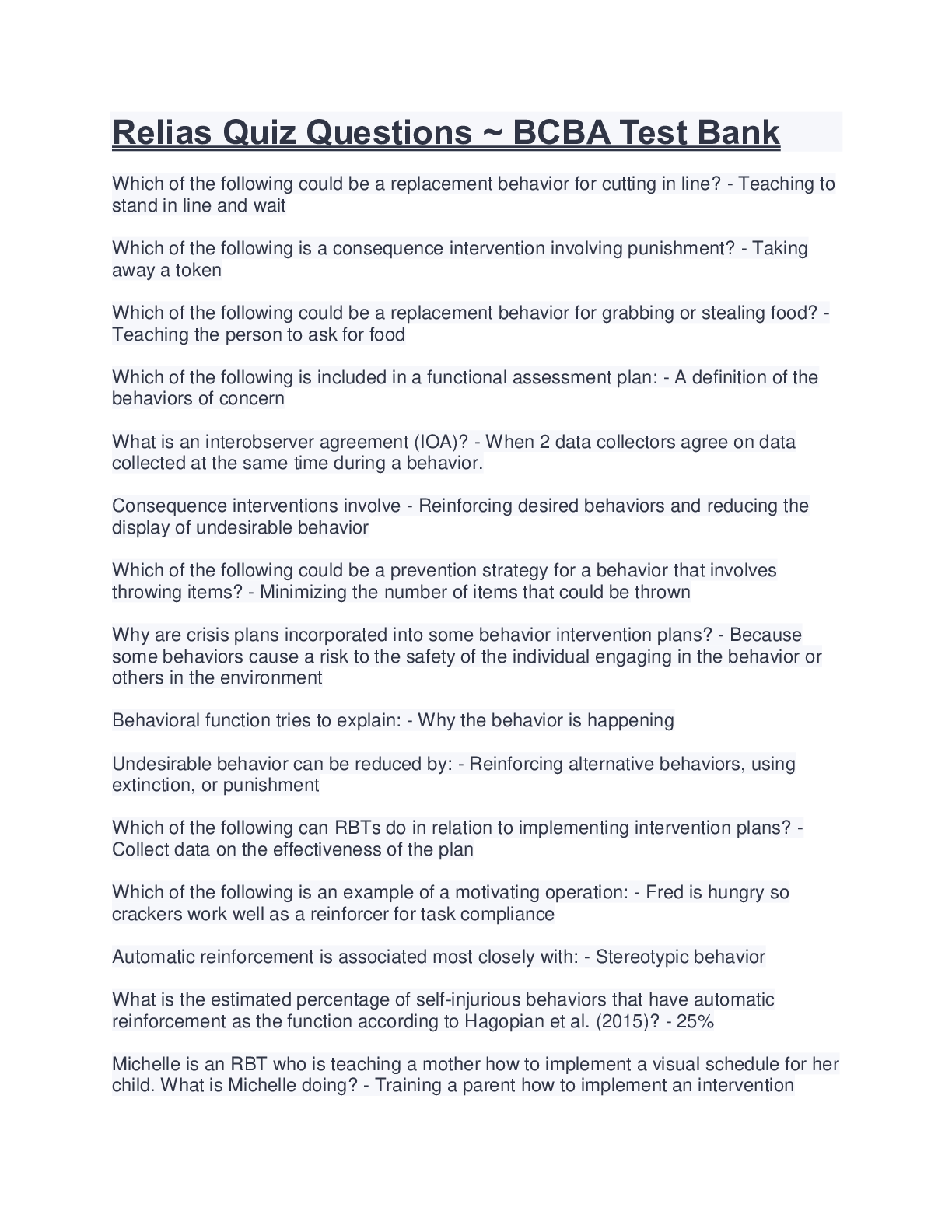
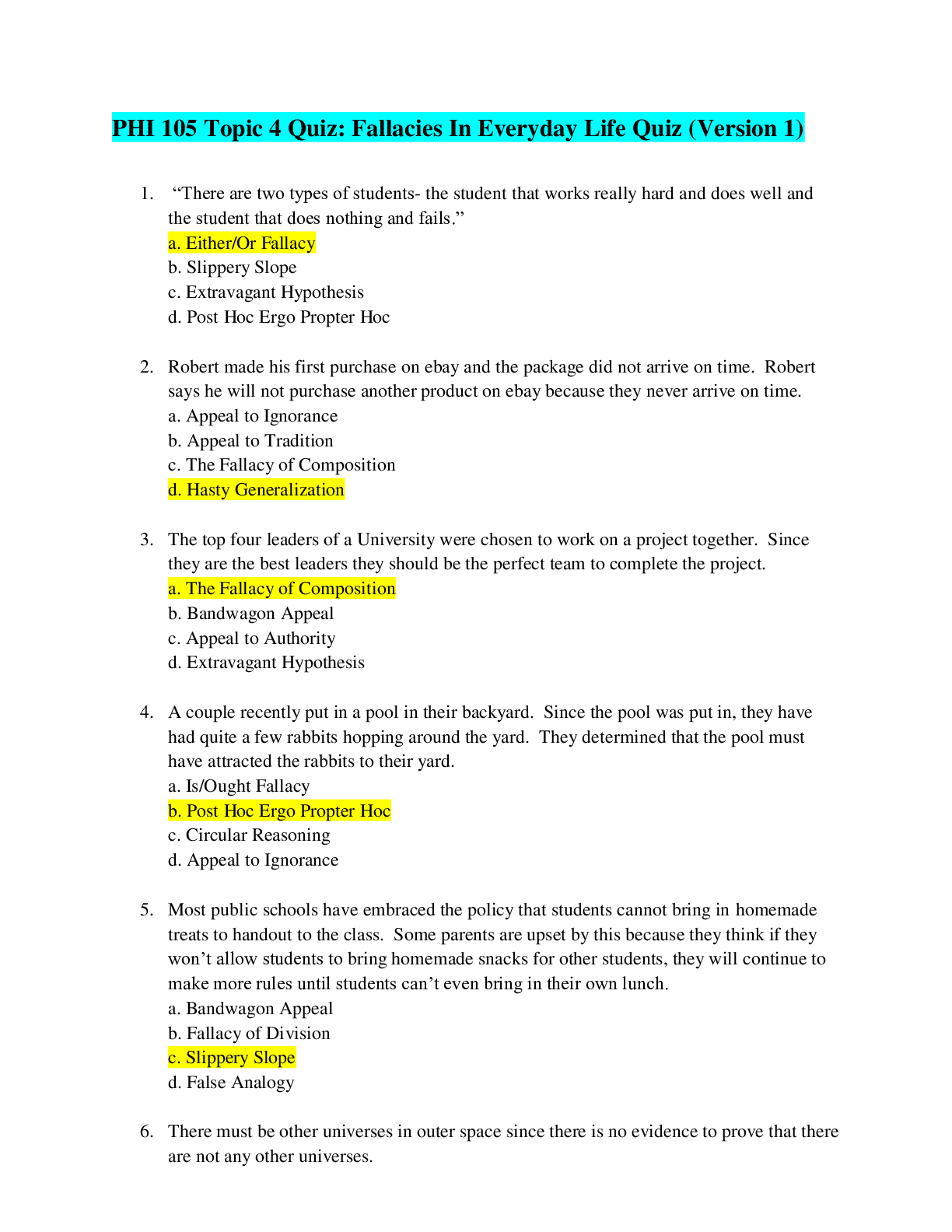


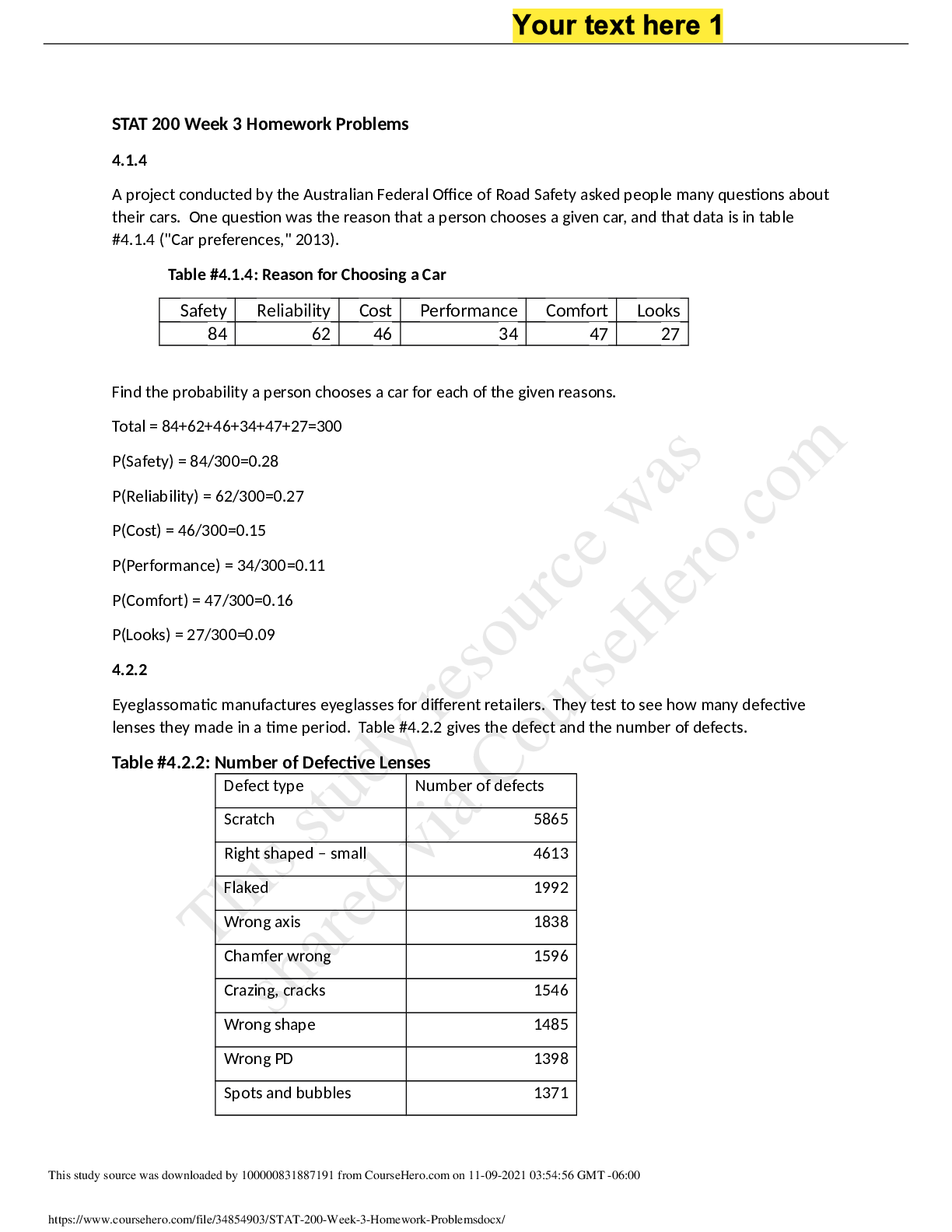

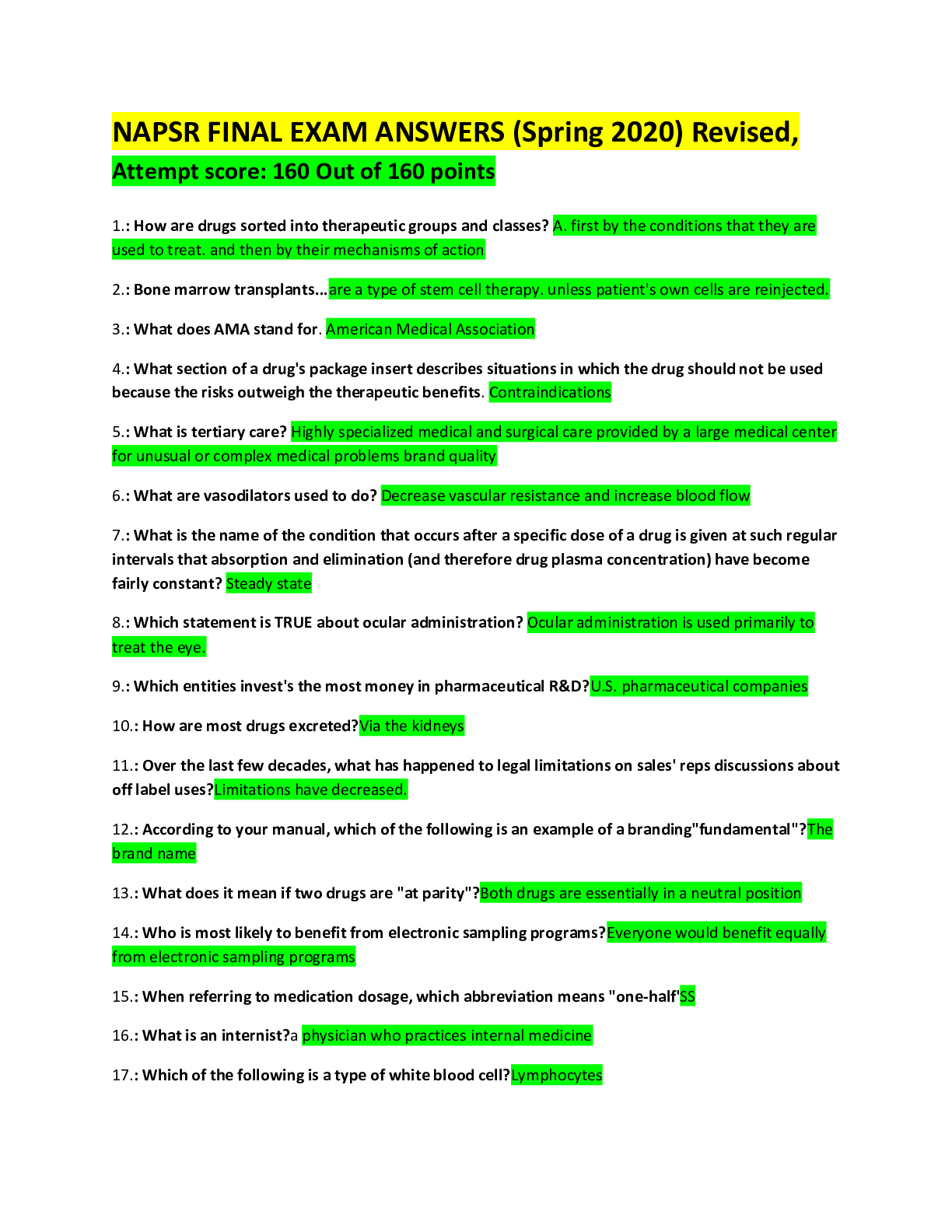

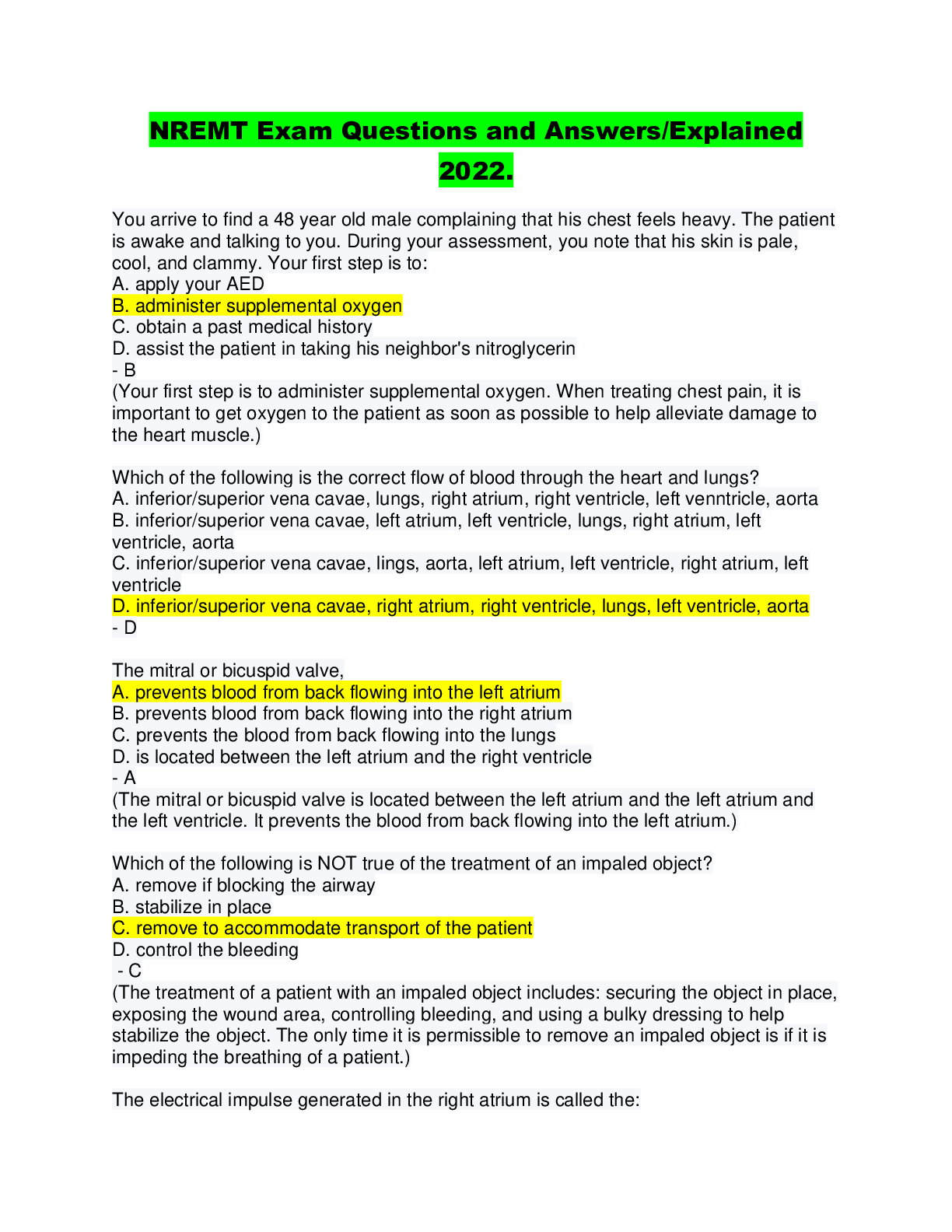
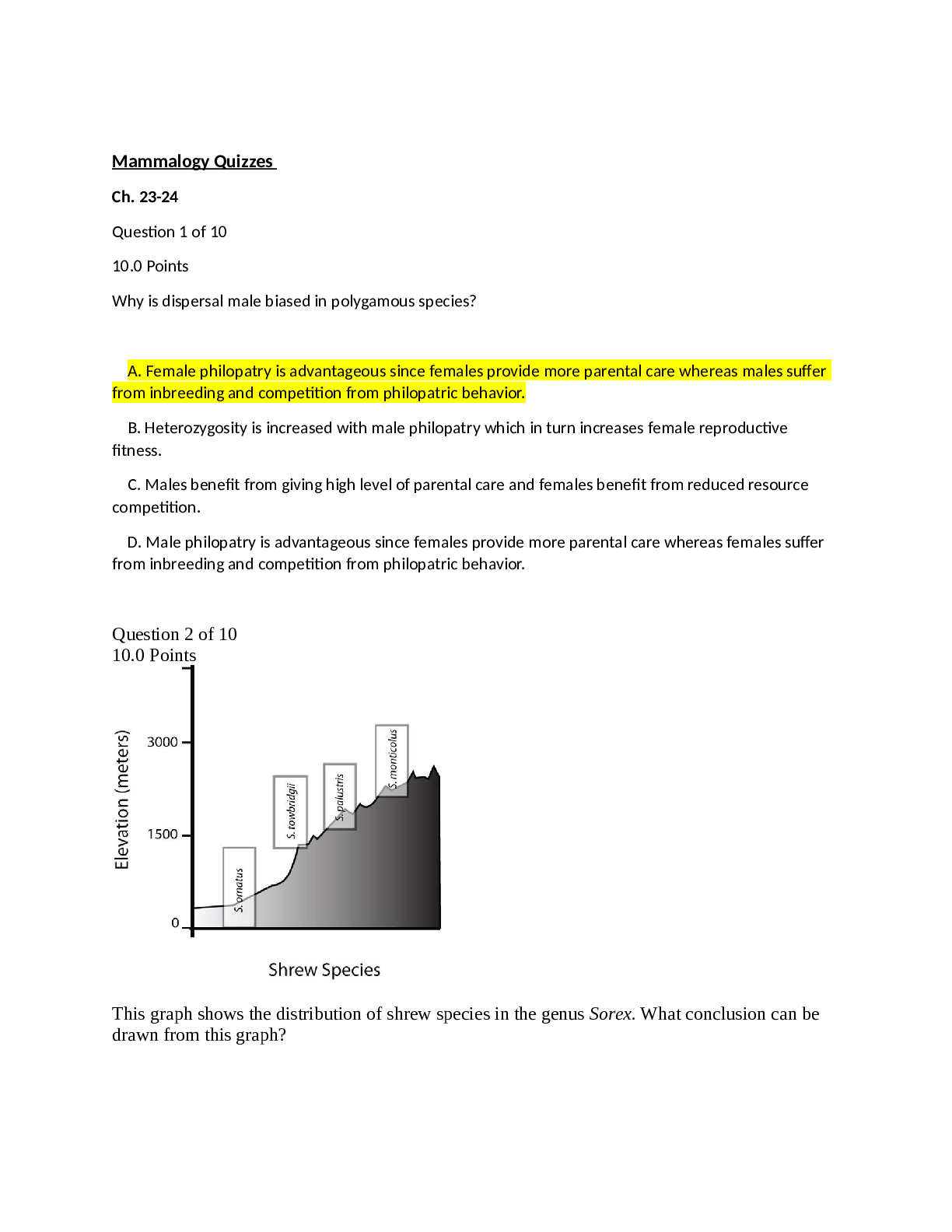
.png)
.png)

